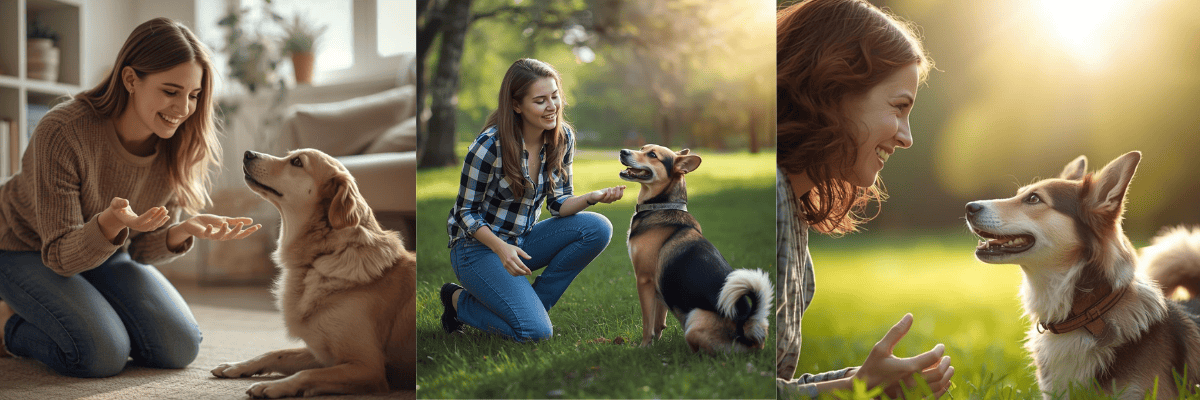Introduction
Communication is the foundation of any strong relationship, and the bond between humans and dogs is no exception. While dogs may not understand every word we say, they are incredibly attuned to our voices, tones, and emotions. Talking to your dog is more than just a way to give commands—it’s a way to convey affection, reassurance, and companionship.
Research has shown that positive verbal interactions can release oxytocin, the “love hormone,” in both dogs and their owners, strengthening emotional bonds and promoting a sense of security. Beyond the science, speaking to your dog regularly helps them feel included in daily life, encourages attentiveness, and can even make training more effective.
In this post, we’ll explore how talking to your dog impacts your relationship, the role of tone and emotion in communication, practical ways to talk to your dog, and fun activities to strengthen your bond. By the end, you’ll have the tools to turn everyday conversations into meaningful moments that enhance trust, affection, and understanding with your furry companion.
1. The Science Behind Talking to Dogs
Dogs are highly sensitive to human voices, and research shows that they can detect not just words, but tone, pitch, and rhythm. While they may not comprehend every word, dogs are experts at interpreting emotional cues embedded in our speech. This ability allows them to respond appropriately, whether it’s with excitement, calmness, or caution.

How Talking Affects the Brain:
Studies have shown that when owners speak in a positive, affectionate tone, both dogs and humans experience a rise in oxytocin levels—the hormone associated with bonding, trust, and social connection. This mutual physiological response strengthens emotional attachment and helps dogs feel secure around their owners.
Key Insights:
- Dogs respond more to how you say something than the actual words.
- Positive verbal interactions create a sense of safety and affection.
- Consistent and gentle communication supports learning, attention, and responsiveness.
Benefit:
Understanding the science behind talking to your dog reinforces why daily verbal interaction matters. Even simple conversations, praise, or narrating activities can significantly enhance trust and connection, forming the foundation for a deeper, more meaningful relationship.
2. Benefits of Talking to Your Dog
Talking to your dog isn’t just a way to issue commands—it has a profound impact on your relationship and your dog’s well-being. Regular verbal interaction strengthens the emotional bond, helps with training, and creates a sense of security.
Key Benefits:
- Strengthens Emotional Connection: Dogs thrive on attention and verbal affection. Speaking to your dog in a positive, calm tone helps them feel loved and valued.
- Enhances Training and Communication: Using clear, consistent words paired with tone improves responsiveness to commands and reduces confusion.
- Reduces Stress and Anxiety: Hearing a familiar, soothing voice can calm anxious dogs, especially in unfamiliar situations like vet visits or grooming sessions.
- Encourages Attention and Engagement: Regular conversation keeps your dog alert, attentive, and more likely to respond to cues or follow your lead.
Examples:
- Praising your dog for following a command or behaving calmly reinforces good behavior and trust.
- Narrating simple activities, like “Let’s go for a walk!” or “Time to eat,” helps your dog understand what to expect and feel included.
- Talking to shy or fearful dogs in a soft tone can gradually build their confidence and comfort level around you.
Bonding Benefits:
Consistent, positive communication builds a deeper understanding between you and your dog. Over time, your voice becomes a source of reassurance, guidance, and affection, helping to create a secure and trusting relationship.
3. How Tone and Emotion Matter
When it comes to talking to your dog, how you say something is often more important than what you say. Dogs are highly sensitive to the emotional cues in your voice, picking up on pitch, volume, and rhythm to interpret your mood and intentions.

Key Points:
- Positive, Calm Tone: Speaking in a gentle, upbeat voice encourages trust and closeness. Dogs are more likely to respond to friendly tones with engagement and affection.
- Harsh or Angry Tone: Yelling, scolding, or using a sharp tone can trigger fear, stress, or avoidance behaviors. Dogs may stop paying attention or become anxious around you.
- Excitement and Praise: High-pitched, cheerful tones work well during play or when praising good behavior, reinforcing positive interactions.
- Calm and Soothing: Soft, steady tones are ideal in stressful situations such as vet visits, grooming, or when your dog is feeling uneasy.
Examples:
- Saying “Good job!” in a cheerful, high-pitched voice after a successful command can encourage repeated positive behavior.
- During a stressful situation, whispering your dog’s name calmly can reassure them and reduce anxiety.
- Narrating daily activities with a happy tone—like “We’re going outside!”—helps your dog anticipate events and feel included.
Bonding Benefits:
Using the right tone builds trust, reduces stress, and helps your dog associate your voice with safety and affection. Over time, dogs learn to read your emotional cues, enhancing communication and strengthening your emotional connection.
4. Practical Ways to Talk to Your Dog
Talking to your dog is not just about commands—it’s about creating consistent, positive communication that strengthens your bond. Here are practical ways to integrate talking into your daily interactions:

1. Use a Friendly, Upbeat Tone During Play or Praise
- Celebrate achievements or good behavior with cheerful words like “Great job!” or “Well done!”
- Pair praise with petting, treats, or playtime to reinforce positive associations.
2. Speak Calmly During Grooming or Stressful Situations
- A soft, steady voice helps your dog feel safe during baths, nail trimming, or vet visits.
- Calm narration can reduce anxiety and make necessary routines less stressful.
3. Narrate Daily Activities
- Simple phrases like “Let’s go for a walk!” or “Time to eat!” help your dog understand what’s happening and feel included.
- Narration creates predictability, which builds trust and security.
4. Pair Words with Gestures or Eye Contact
- Combine verbal cues with hand signals or eye contact to clarify your message.
- This multisensory approach reinforces communication and strengthens connection.
5. Consistency is Key
- Use the same words and tone for commands or daily phrases to avoid confusion.
- Repetition helps your dog learn faster and increases responsiveness.
Bonding Benefits:
By incorporating these practical techniques, talking to your dog becomes an interactive, trust-building activity. Your dog learns to associate your voice with guidance, comfort, and affection, enhancing the overall relationship.
5. Common Mistakes to Avoid
While talking to your dog can strengthen your bond, certain mistakes can reduce trust, create confusion, or even cause anxiety. Being aware of these pitfalls helps ensure your communication remains positive and effective.
Common Mistakes:
- Using Confusing or Inconsistent Words/Commands:
- Switching words for the same action (e.g., “sit” vs. “sit down”) can confuse your dog and slow training progress.
- Yelling or Excessive Scolding:
- Harsh tones can trigger fear or stress, making your dog less responsive and less trusting.
- Ignoring Your Dog’s Reactions or Body Language:
- If your dog shows signs of discomfort, anxiety, or confusion, continuing in the same tone can strain the bond.
- Talking Too Much Without Context:
- Random chatter without clear cues or interaction may not engage your dog meaningfully.
Bonding Benefits:
Avoiding these mistakes ensures that talking becomes a positive, trust-building experience. Dogs respond best to clear, consistent, and gentle communication, helping them feel secure, understood, and emotionally connected to you.
6. Fun Communication Activities
Turning talking into a playful and interactive experience can strengthen your bond while keeping your dog engaged and happy. Here are some fun ways to communicate:
1. Reading Aloud or Narrating Daily Tasks
- Read a book, newspaper, or even talk through household activities.
- Dogs respond to the sound and rhythm of your voice, and this helps them feel included and connected.
2. Singing or Using Rhythmic Phrases During Play
- Sing a simple song or chant during walks, fetch, or play sessions.
- Rhythmic speech grabs attention and makes interactions more engaging and memorable.
3. Training Games Using Verbal Cues
- Teach new commands with consistent words paired with praise and treats.
- Games like “find it” or “go get it” with clear verbal instructions stimulate the mind and reinforce communication.
4. Positive Reinforcement Storytelling
- Describe your dog’s actions while praising them: “You’re sitting so nicely!” or “Good boy for staying!”
- This reinforces good behavior while making your dog feel acknowledged and appreciated.
Bonding Benefits:
These activities make verbal communication fun, engaging, and meaningful. Dogs begin to anticipate positive interactions when they hear your voice, enhancing trust, attentiveness, and emotional connection. Over time, these moments of shared communication create a stronger, more fulfilling bond.
Conclusion
Talking to your dog is more than just giving commands—it’s a vital form of communication that strengthens trust, understanding, and emotional connection. By speaking with positive tone, consistency, and attention to your dog’s reactions, you create an environment where your dog feels safe, loved, and included.
Mindful verbal interaction, combined with gestures, eye contact, and gentle reinforcement, helps your dog understand you better and deepens the bond you share. Whether narrating daily activities, praising good behavior, or using fun training games, every conversation becomes an opportunity to build closeness.
Incorporating regular, meaningful communication into your daily routine fosters a fulfilling relationship, enhancing both your dog’s well-being and your connection. Remember: your voice is a powerful tool for love, guidance, and companionship—use it to create an unbreakable bond with your furry friend.




Leave a Reply